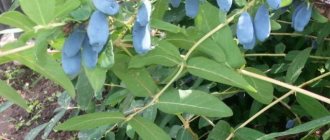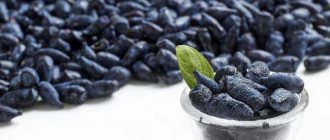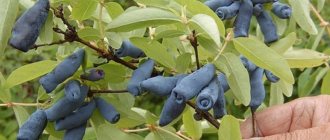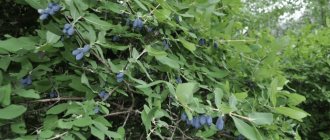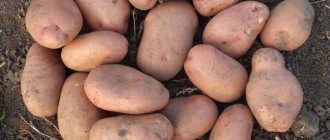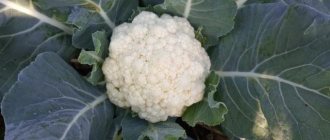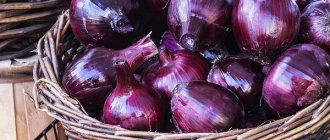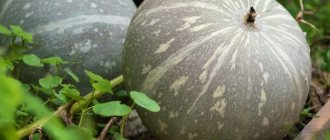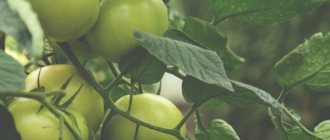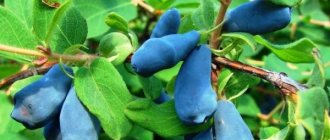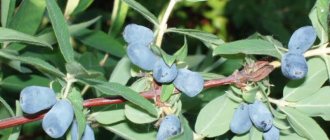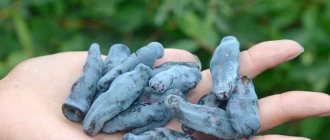Photos and descriptions of the Lazurnaya honeysuckle variety will help beginning gardeners decide whether this variety is suitable for them. One of the main advantages of the shrub is its high resistance to fruit shedding, which formed the basis of its popularity. In addition, it differs from many related varieties in its excellent immunity and immunity to fungal diseases.
Description of honeysuckle variety Lazurnaya
Honeysuckle Lazurnaya is a medium-ripening variety bred by Siberian breeders of the Barnaul NIISS. The first berries appear on the bush only on June 20-24. Fruiting lasts about a month, but if the year is warm, it may bloom a second time. If this happens, there may be no harvest next year.
The Lazurnaya variety is classified as medium-sized - the bush grows on average to 1.5-1.7 m in height. The crown of the shrub is obverse-conical, with thin, non-pubescent shoots of light green color. If the summer is sunny, they may acquire a pinkish tint.
The leaves of the honeysuckle variety Lazurnaya are large and oval in shape, as can be seen in the photo below. The berries are slightly elongated, with a thickening in the middle. The weight of the fruit can reach 1.5 g. The skin of the berries is dark blue, with a bluish coating on the surface. The pulp is tender, with a pleasant sweet and sour taste and blueberry aroma.
Important! With good care, you can harvest about 2.5 kg of harvest from each bush.
Unlike most varieties, the berries of Azure Honeysuckle do not fall off immediately after ripening, which makes them much easier to harvest
History of creation
This variety was selected in Siberia. In terms of ripening time, Lazurnaya honeysuckle is a mid-season plant. The first sowing of seeds was done back in the sixties of the twentieth century. The creators of the variety are Z. P. Zholobova, I. P. Kalinina, and Z. I. Luchnik. Although the first sowing was done in 1965, the variety was accepted for State testing in 1989. However, despite this, the variety was not included in the Register of Breeding Achievements of the Russian Federation.
In Siberia, wild honeysuckle has long been enjoyed. At the Barnaul NIISS, breeding work was carried out, pollinating Kamchatka honeysuckle, and one of the results was the creation of a new variety - Luchezarnaya honeysuckle was obtained.
Honeysuckle berries
Planting and caring for honeysuckle Lazurnaya
The most important thing when planting honeysuckle is that the seedling should never be buried too far into the ground. Such a bush will grow slowly and bear little fruit.
It is equally important to maintain the distance between neighboring bushes. The recommended planting scheme for the Lazurnaya variety is 1.5-2 m, no less. More concentrated planting will result in plants competing for water and nutritional resources, which will negatively affect the fruiting of seedlings.
How to choose a landing site
This variety is not particularly picky about soil composition, but the plant prefers light, slightly acidic soil. Places with slightly podzolized and loamy soil are also suitable.
As for the level of illumination, preference should be given to open areas. In the sun the berries turn out large and tasty, while in the shade the fruits become smaller and then become very sour.
Advice! It is better to plant the Lazurnaya variety along fences or residential buildings; they will serve as good protection from cold northern winds.
Watering
Water the plantings regularly, but moderately. Plants should not be overwatered to avoid causing rotting of the roots. The optimal frequency of watering is 1-2 times a week, and no more than 1 bucket of water is spent on each bush. You can moisten the soil both in the morning and in the evening.
Stagnation of water is detrimental to the root system of honeysuckle, therefore, if groundwater lies too high in the area, it is necessary to lay out a drainage layer at the planting site.
Feeding
The Lazurnaya variety is usually fertilized in spring and autumn. First, organic and mineral mixtures with a high content of nitrogen and potassium (humus, horse humus, superphosphate, potassium salt) are used as fertilizers. In the autumn months, wood ash is added to the soil.
Advice! Nitrogen fertilizers can be used before fruiting begins. After the bush begins to set fruit, the composition of the fertilizer is changed.
Trimming
From time to time, Honeysuckle Azure needs to be pruned to increase the yield of the bush and the size of the fruit. For the first time, the shoots are shortened before planting the seedling so that it branches better. Annual pruning is usually carried out in the spring, when the buds begin to bloom, but it is also possible to form a shrub in the fall.
Important! In the second case, you need to have time to prune the plant before the first frost.
Branches are pruned so that stumps about 30-40 cm long remain. All weak, dried out or broken shoots must be treated. Branches growing inside the bush are also removed to avoid thickening.
In the spring, you need to inspect the bush and cut off all frozen branches.
Preparing for winter
Despite the fact that honeysuckle of the Lazurnaya variety is a winter-hardy variety, it would be a good idea to cover young bushes for the winter. To do this, it is enough to mulch the tree trunk circle with horse humus. Young bushes can be additionally sprinkled with straw and spruce branches - they will protect the root system of honeysuckle from severe frosts in a snowless winter.
Characteristics and Features
Honeysuckle Nymph
The height of the bushes usually reaches about 1.7 meters. The spreading nature of the shrub is characterized as average. The shape of the crown is reverse-conical - it gradually expands towards the top.
The berries have a pleasant, sweet taste with a slight hint of sourness. At the same time, a subtle blueberry aroma may be felt. Their flesh is tender. The berries are well suited for fresh consumption. The shape is oval, but elongated. The tip is slightly elongated. The stalk is long and thin. The weight of one berry ranges from 0.9 to 1.4 grams. The color is as indicated in the name of the variety - azure or purple. At the same time, you can sometimes see spots of a light, waxy coating on the berries.
The taste was assessed by professional tasters. On a five-point scale, it was approximately 4.7-4.8 points.
The leaves can be classified as elongated-oval. They have a pleasant light green color. During periods of intensive growth and in bright sunlight, the leaves may acquire a slight reddish tint.
Honeysuckle variety Lazurnaya can be used as a folk remedy for certain health problems:
- Berries will support the body well during exhaustion;
- If poor heart function has led to the formation of edema, then in this case it will be useful to eat the berries of Honeysuckle Azure;
- This remedy may help with decreased appetite;
- Honeysuckle is considered one of the remedies that will help avoid premature aging;
- If there are tumors (benign or malignant), this remedy will help make life a little easier;
- Helps with hypertension and in case of hypertension;
- If a person has poor blood circulation, eating berries will help improve it;
- Honeysuckle heals if a person suffers from a sore throat, colds, and various diseases of the upper respiratory tract;
- The berries are useful for those who suffer from liver or kidney diseases.
In some cases, eating honeysuckle berries is not recommended.
It is believed that they will not be beneficial if:
- allergy;
- chronic gastritis, which is accompanied by high acidity;
- stomach ulcer.
The composition of the berries can be characterized as follows:
- Approximately 3.04% is sugar;
- The acid content here is no more than 1.85%;
- Vitamin C is present here. Its content is 22.7 mg per 100 g or less;
- There is also vitamin P in an amount of no more than 1010 mg per 100 g of berries.
This variety can be recommended for a variety of uses, including compotes, jellies, jams, juices or wines.
The harvest time for this variety is in June. It is important to note that the shedding of berries is insignificant. The shrub bears fruit starting from the third or fourth year after planting. At the same time, you can enjoy the berry harvest every year, throughout the remaining life of the bush.
The berries are ripe
Yield indicators change throughout the life of the plant. When the bush is still young, it is low - ranging from 0.5 kg to 1.5 kg per bush. When the age reaches seven years, the situation changes. Now the varietal yield per bush is 2.3 kg. This figure corresponds to a harvest of seven tons per hectare. Once the age of honeysuckle reaches 14 years, the yield will almost double. At this time, 13.3 tons of berries can usually be collected from one hectare.
Important! The description of the Lazurnaya honeysuckle variety suggests that this shrub tolerates winter well and has good resistance to insect pests and diseases.
Pollinators of honeysuckle Lazurnaya
All varieties of honeysuckle require cross-pollination, and the Lazurnaya variety is no exception to this rule. Despite the fact that the shrub is partially self-fertile, to obtain a good harvest it is necessary to plant several more bushes nearby. The following species go well with Honeysuckle Azure:
- Gerda;
- Cinderella;
- Blue bird;
- Blue spindle;
- Long-fruited.
Honeysuckle varieties for the northern regions of Russia
Due to the harsh northern climate, not all berries can be grown in Siberia. But honeysuckle is so frost-resistant that its first berries appear already in early June. Breeders have obtained special varieties of honeysuckle suitable for planting in the northern regions.
Azure
Berry weight 1 g. The pulp is sweet and sour with a bitter taste. Productivity up to 2 kg. Secondary flowering is possible, but this has a bad effect on yield. Fruit shedding is weak.
Fire opal
Berry weight up to 1 g. The pulp is sweet and sour with a bitter taste. The yield is high - up to 4 kg per bush. Practically does not fall off. Most often, wine is made from the berries of this variety.
In memory of Gidzyuk
Bush 1.8 meters high. Pear-shaped berries weighing up to 1 g. The yield reaches 2-3 kg per bush. The berries do not fall off. The application is extensive.
Laura
Berries weighing 1.1 g. The pulp is tender, the taste is sweet, aromatic. Shedding average Use fresh and for processing.
Volkhova
The bush is tall up to 2 m. The berries are elongated with a pointed tip, weighing up to 0.9 g. The taste is sweet with a hint of strawberry. Productivity up to 2 kg per bush. The berries fall slightly. Use as a dessert.
Lenarola
Berries weighing 1.2 g. The taste is sweet and sour, the pulp is aromatic, the skin is thick. Decorative large flowers. Moderately resistant to aphids, average shedding. Use in desserts and fresh. Productivity up to 2 kg per bush.
Also suitable for planting in the regions of Siberia are the above-described honeysuckle varieties Tomichka, Zolushka and Bakcharsky Velikan.
Southern varieties include Dolphin, Golubinka, Rassvet, Zarnitsa. It is better not to plant them in areas of the middle zone. Because in the case of a warm autumn, they can bloom again, which will significantly reduce the harvest and weaken the plant.
Reproduction of edible honeysuckle Lazurnaya
The most effective method of propagating honeysuckle variety Lazurnaya is green cuttings. The whole process can be divided into the following stages:
- As soon as the bush fades, the cuttings are cut from the honeysuckle along with the base (heel). You can also start harvesting cuttings during the formation of fruit ovaries. As a result, each shoot should have at least 4 buds.
- The next step is to soak the resulting blanks in a solution of a root formation stimulator. It is enough to keep the cuttings in it for a couple of hours.
- Then they begin to prepare the soil for planting material. To do this, mix peat with soil in a ratio of 1:3. For prevention purposes, it is recommended to treat the soil with any industrial fungicide.
- When the soil is ready, the cuttings are buried in individual containers with a slope of 30-40 °.
- After this, the soil is abundantly moistened and the workpieces are covered with glass.
- Throughout its growth, the Lazurnaya honeysuckle planting material must be carefully looked after - ventilate the seedlings from time to time and water it moderately. After 2 weeks, the cuttings will begin to form their own root system.
- By August, honeysuckle seedlings should form sufficiently developed roots. After that, they are placed in a school for growing up.
At this point, the process of propagation of honeysuckle variety Lazurnaya can be considered complete. Young bushes are regularly watered and mulched with peat. With the onset of the first frost, the plantings are covered with spruce branches and straw. In August next year, Honeysuckle Azure can be transplanted into open ground.
You can learn more about how to propagate honeysuckle from the video below:
Edible early ripening honeysuckle varieties
Edible honeysuckle varieties that ripen early will bear fruit earlier than all other berries. At the same time, they are valued for their taste and healing properties.
Variety Blue Bird
One of these early varieties is Bluebird honeysuckle. It is a fruit shrub that reaches a height of up to 1 meter. The ellipsoidal berries grow 2 cm long. This variety is easy to care for, tolerates frosty winters well and has low shedding.
The Blue Bird variety is self-sterile. In order for it to bear fruit, it is necessary to plant several more types of self-pollinating honeysuckle. Cross pollination will allow you to achieve a good harvest.
Honeysuckle Leningrad giant
Another early variety can be considered honeysuckle Leningrad giant. Its berries are quite large and elongated, with a sweet and sour taste and strong aroma. The bush can grow to a height of more than one and a half meters. It tolerates winter well and is resistant to diseases and all kinds of pests. In order for the bush to bear fruit, it is necessary to plant pollinating varieties nearby. They could be Morena, Malvina, etc.
Honeysuckle Morena
Honeysuckle Morena is considered early ripening, the description of which is given. It is characterized as a winter-hardy crop with large fruits (2.5 - 3 cm) and high yield. The berries have a sweet and sour taste and a faint aroma. This variety is self-pollinating, so it does not require additional varieties in the neighborhood. The fruits stay well on the bush for a long time and do not fall off.
Features of cultivation
The shrub grows well on loamy soils. He likes the land to be well watered and provided with sufficient fertilizer. Neutral or slightly acidic soil is best suited for growing, but slightly or medium podzolic soil, as well as sandy loam soil, would also be a good option.
Soil characteristics are important for honeysuckle. If it is too acidic, it must be processed accordingly. Usually ground limestone or dolomite flour is used for this. It is enough to use 50 g of powder per hole.
It is not recommended to bury the seedling too deeply when planting. This can lead to unpleasant consequences: from slowing growth to rotting roots. Seedlings must maintain a certain minimum distance between each other. They cannot be placed closer to each other than one and a half or two meters.
When planting, honeysuckle must be provided with fertilizers. After this, fertilizing is done every spring. In this case, you can use both organic and mineral fertilizers. The first ones to use are humus or horse humus. It will require from 8 to 10 kg per square meter. In the second case, we can recommend the following mixture for the same area: 50 g of potassium salt and 80 g of superphosphate.
It would also be a good decision to buy a ready-made complex fertilizer. In this case, it will be enough to use 20-30 g per square meter.
It should be taken into account that nitrogen fertilizers can be used for care only in the period before fruiting begins. In addition to the above, it is recommended to add wood ash to the soil. This is done in late autumn at the rate of 100 g per square meter. After this, it is recommended to dig up the ground so that the ash is well mixed.
After fertilizing, the soil must be thoroughly dug up. This needs to be done to the depth of the bayonet of the shovel. Next, you need to prepare holes for each bush. It is believed that it is best to make ones with a depth of 35-40 cm, width and length of 40-50 cm.
Before planting, soil from the top layer is poured there at two-thirds of the depth, which is mixed with the fertilizers necessary for the growth of honeysuckle. It is recommended to prepare the pits two to three weeks before planting the seedlings.
Honeysuckle loves good sunlight. It will be nice if the bush is protected from the wind by a fence, the wall of a house, or specially planted plants that will protect it from the cold wind. An example of the latter option would be planting corn.
The plant loves regular watering. It is advisable to do it at least once or twice a week. In this case, it is necessary to avoid situations where water stagnates. To prevent this from happening, you can make a drainage layer.
The root system of Azure honeysuckle is located in the surface layer of soil. In order to retain moisture, mulching is usually carried out. For this, organic materials are usually used.
The process of plant pollination is important. It is believed that Azure honeysuckle has a self-fertility rate of 27%. In order to ensure the possibility of cross-pollination, bushes of some other varieties are planted with it.
For this, the following pollinator options are used:
As the plant grows, the gardener needs to prune it. At the same time, old, diseased or broken branches are removed. It is customary to carry out this procedure annually. Additionally, pruning is done every 2-3 years: branches that are more than five years old are removed.
Starting from mid-July, honeysuckle gradually begins to prepare for the winter period. This can be seen, in particular, by how the leaves gradually begin to dry out. Although the plant is frost-hardy, it can be helped to withstand severe frosts by mulching the soil surface with horse manure.
Edible honeysuckle Azure: main characteristics
Today, about 190 cultivated and wild species of honeysuckle are known to exist. Most of them are poisonous. Edible species and varieties can be grown in summer cottages and garden plots in order to obtain tasty and healthy berries. We’ll talk about one of these varieties called Lazurnaya in our material today.
Description of the honeysuckle variety Lazurnaya
Before deciding to cultivate honeysuckle in your garden, you need to read the description of the plant, learn about its preferences, features of planting, cultivation and care.
History of selection
Honeysuckle Azure was obtained at NIISS, located in Barnaul, in 1965. Its authors are Z. Zholobova, I. Kalinina and Z. Luchnik. Breeding took place by selecting seedlings that appeared as a result of free pollination of the Kamchatka honeysuckle variety Start. Despite the fact that the plant was approved for testing at the state level, it was never included in the State Register of the Russian Federation.
Appearance, characteristics of berries, ripening time, yield
The Lazurnaya honeysuckle variety grows bushes of medium height - they do not exceed 1.7 m. Their crown has the shape of an inverse cone. The bushes are characterized by medium spreading. The branches are thin, light green in color. The leaves are large in size, oval in shape. There is slight hairiness on the leaf plates. The berries ripen in mid-June.
The first fruiting occurs in the third or fourth year after planting. The fruits are large, weigh 0.9–1.4 g. They reach 1.5–2 cm in length. They are oval, conical, and elongated in shape. The top of the berries is pointed. The skin has a medium density. It is painted dark blue with a bluish tinge. The pulp is characterized by tenderness, sweet and sour taste, and blueberry aroma. The taste qualities are high, rated by tasters at 4.5–4.6 points out of 5 possible.
Honeysuckle berries are beneficial for the human body because they contain sugar (3% of the daily value for humans), vitamin C (33%), B1 (200%), B2 (166%), K (66%). The fruits can be eaten fresh, and can be used to make jellies, compotes, juices, jam, and wine. The yield of mature bushes of the Siberian Lazurnaya variety was noted at 2.3 kg per bush or 7 t/1 ha. Young specimens bear up to 1.5 kg of berries. The variety has a high level of frost resistance, prefers abundant watering, and is partially self-pollinating. The lifespan and fruiting life of honeysuckle is about 20 years.
Advantages and disadvantages of the variety
- According to reviews of gardeners who have experience in cultivating Lazurnaya honeysuckle, among its positive characteristics are the following:
- large fruit;
- high taste of berries;
- winter hardiness;
- strong immunity;
- partial self-fertility;
- berries are not prone to shedding.
The disadvantages of the variety include a low level of productivity at an early age.
Agricultural technology
The success of growing honeysuckle depends on choosing a good place for planting, choosing a high-quality seedling and carrying out regular care.
Selecting a location
Honeysuckle prefers well-lit areas. When planted in the shade, it produces sour and small fruits in small quantities. The place should be well sheltered from drafts. The optimal placement of honeysuckle bushes is near the fence. The permitted depth of groundwater is 1.5 m. It is important that there is no stagnation of moisture in the area, otherwise the plants will get sick and grow poorly.
If there is no other option than planting in a place where water stagnates, then it is necessary to organize good drainage that removes excess liquid. Honeysuckle grows and bears fruit best in light, fertilized loamy or sandy loam soils with a slightly acidic or neutral reaction.
Planting and care
In addition to choosing a good location, you should also choose high-quality planting material. You should go to a specialized store or nursery to get it. Usually annual seedlings or rooted cuttings are sold. When purchasing, you should give preference to specimens no higher than 1.5 m, with a well-developed root system, a healthy root collar without growths and spots. Planting can be done in the spring - in mid-April, before the start of the growing season, and in the fall - in the tenth day of October.
When planting in spring, it is recommended to prepare the site in the fall. It needs to be cleared of plant debris, dug deep, and leveled. Holes can be dug 1.5–2 weeks before planting. The recommended size of the holes is 40x40x40 cm. The distance between them is 1.5–2 m, between the rows — 2–3 m. Humus or decomposed manure (10–12 kg), double superphosphate (100 d), potassium sulfate (30 g), wood ash (300 g).
Planting a seedling must be done as follows:
- Fill the hole 2/3 with fertilized soil, forming a small hill from it.
- Place a seedling on it. The root collar should be located 5 cm below the edge of the hole.
- Spread the root system, distributing it evenly over the ground.
- Fill the voids with soil.
- Perform compaction.
- Moisten using 10 liters of water.
- Pour a layer of mulch from soil, peat, humus.
